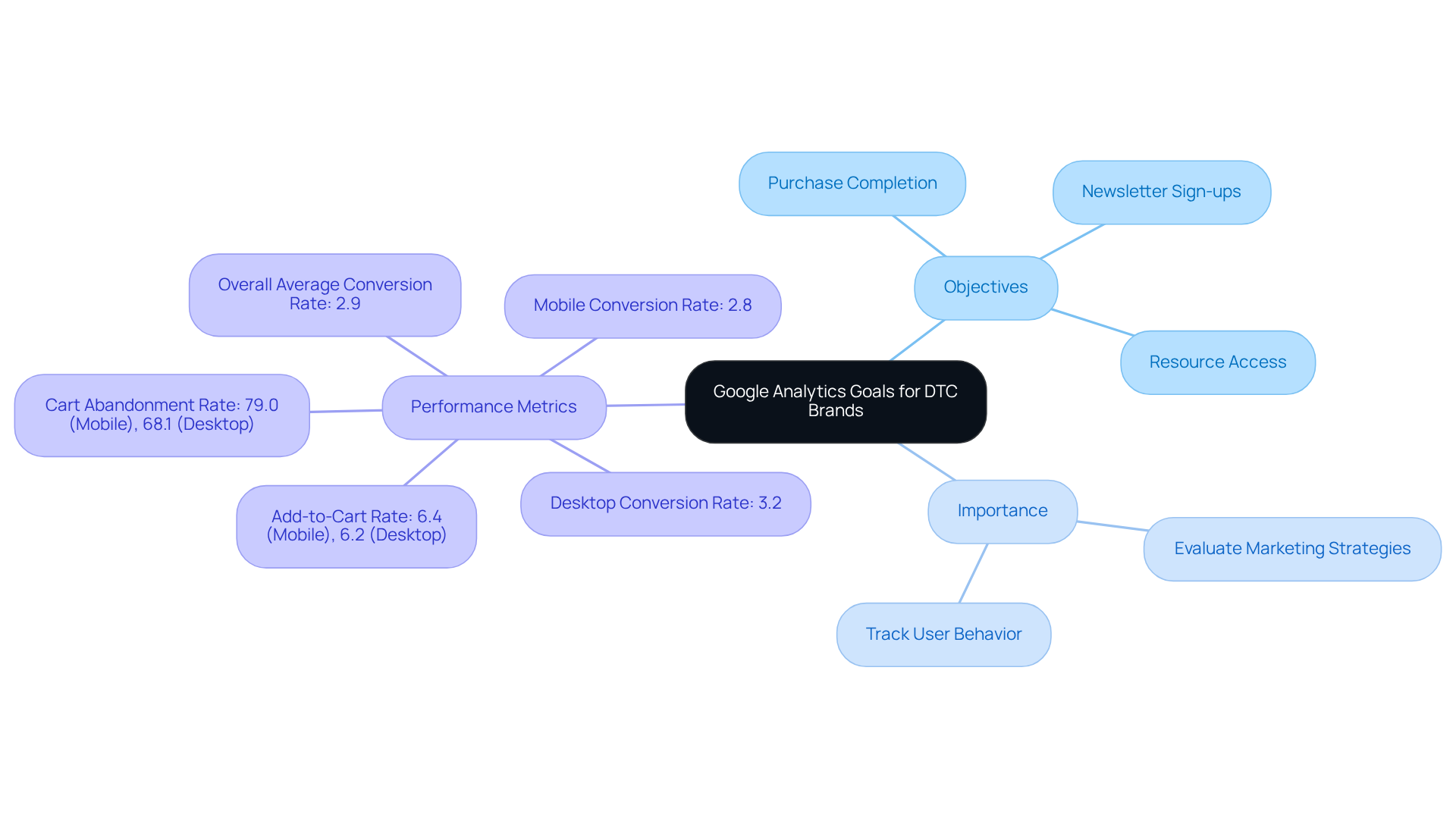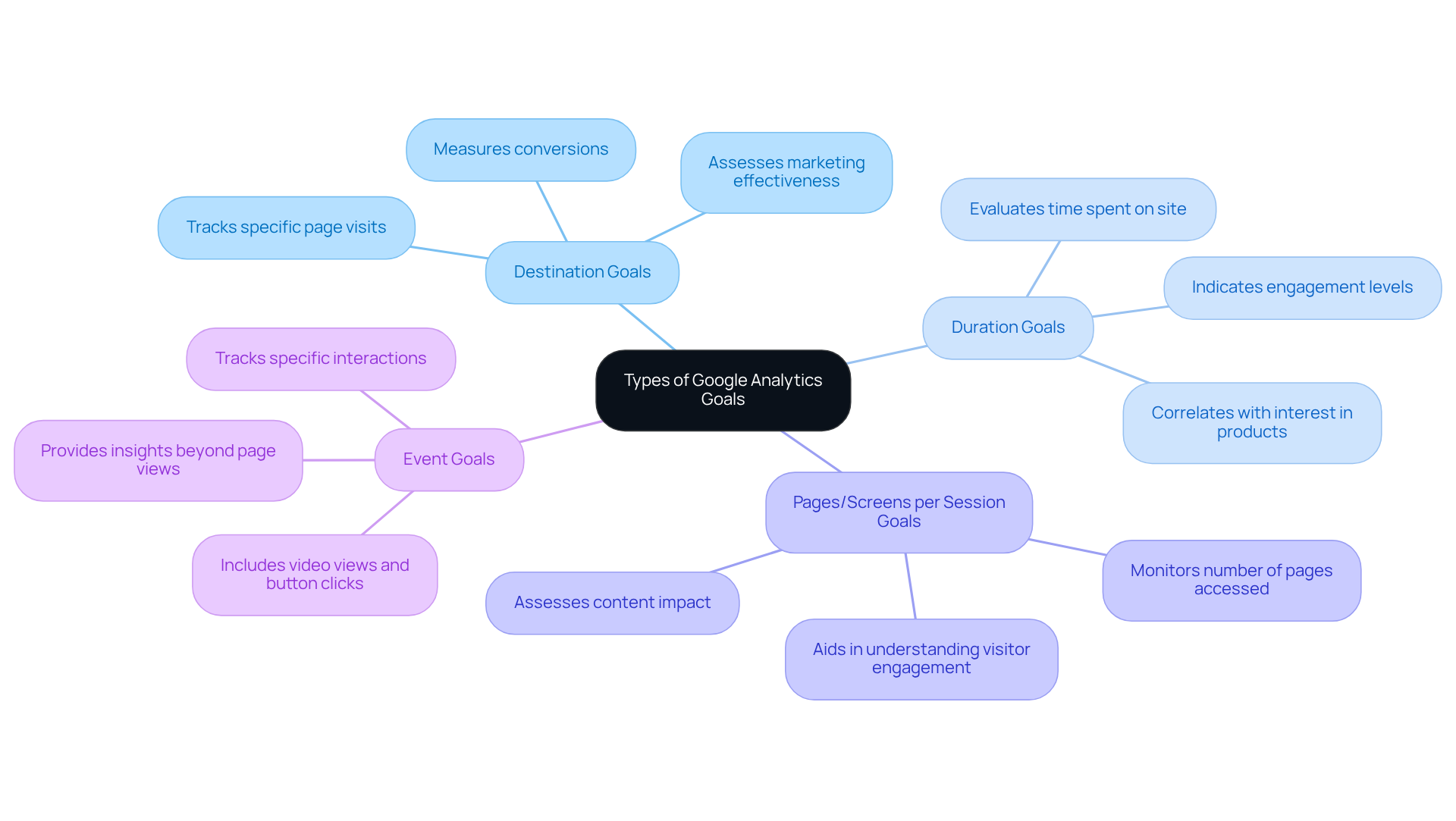
Overview
This article presents best practices for DTC brands aiming to master Google Goals Analytics. It underscores the necessity of defining clear objectives as a means to enhance marketing effectiveness and improve sales performance. By detailing various goal types and their connection to user events, it emphasizes the importance of aligning these objectives with overarching business aims.
Utilizing SMART criteria further supports informed decision-making, ultimately leading to increased conversion rates. Implementing these strategies will empower brands to achieve their marketing goals with confidence.
Introduction
Understanding the digital landscape is paramount for direct-to-consumer (DTC) brands aiming to excel in a competitive market. Google Analytics Goals represent a formidable tool for these companies, empowering them to define precise objectives that can significantly elevate their marketing strategies and overall performance. The challenge, however, lies in effectively harnessing these analytics—not merely to track user behavior but to foster meaningful engagement and drive conversions.
How can DTC brands master the art of Google Goals Analytics to unlock their full potential and adeptly navigate the complexities of consumer behavior?
Define Google Analytics Goals and Their Importance for DTC Brands
Google Analytics objectives represent specific aims that DTC companies seek for their website visitors to achieve, such as completing a purchase, signing up for a newsletter, or accessing a resource. Establishing these objectives is crucial for evaluating the effectiveness of marketing strategies and website performance. By defining clear objectives, companies can track user behavior, identify barriers in the sales process, and make informed, data-driven decisions to enhance user experience and improve sales rates.
For example, a DTC company that sets an objective for newsletter sign-ups can evaluate the effectiveness of their lead magnets and refine them as necessary. This focused approach not only boosts engagement but also drives increased sales through targeted email marketing campaigns. Indeed, companies that effectively leverage Google Goals Analytics to assess their marketing efficiency often experience significant improvements in performance metrics. With the for mobile at 2.8% and desktop at 3.2%, the potential for growth is substantial when goals are strategically defined and monitored.
Furthermore, successful DTC companies utilize Google Goals Analytics to gain insights into customer behavior, enabling continuous enhancement of their marketing efforts. By analyzing visitor engagement and adapting strategies based on data, these companies can elevate their overall marketing effectiveness, ultimately leading to greater profitability and improved customer retention.

Explore Types of Google Analytics Goals: Destination, Duration, and More
Google Goals Analytics provides essential objectives that DTC brands can leverage to monitor interactions effectively. Understanding these objectives is crucial for and achieving business goals using Google Goals Analytics. The primary goal types are as follows:
- Destination Goals: These objectives track when an individual reaches a specific page, such as a thank-you page after a purchase. This metric is vital for measuring conversions and assessing the effectiveness of marketing efforts.
- Duration Goals: These goals evaluate how long visitors spend on your site, serving as an indicator of engagement levels. A longer duration typically correlates with a heightened interest in your products and services.
- Pages/Screens per Session Goals: This objective monitors the number of pages accessed during a session, aiding companies in understanding visitor engagement and the impact of their content.
- Event Goals: These goals track specific interactions, such as video views or button clicks, providing insights into user behavior that extends beyond mere page views.
By grasping and implementing these objective types, DTC brands can utilize Google Goals Analytics to obtain a comprehensive view of interactions, enabling them to refine their strategies and drive better results.

Understand the Relationship Between Goals and Events in Google Analytics
In Google Goals Analytics, the relationship between goals and events is intricately linked, with events serving as essential components for achieving the specified goals. Events signify interactions with content that can be monitored independently from page loads. For example, a DTC company aiming to track clicks on a promotional banner would establish an event for that specific interaction. Once this event is established, it can be linked to a goal, such as increasing the number of individuals who visit a product page.
This connection empowers companies to create a comprehensive analytics system with Google Goals Analytics that not only tracks outcomes but also provides insights into consumer behavior leading to those outcomes. By leveraging this knowledge, brands can implement targeted enhancements, ultimately driving higher success rates.
Organizations that set specific objectives related to user engagement, such as monitoring time spent on a page or the number of pages viewed, can significantly refine their strategies for achieving desired outcomes. This method has been shown to , with the average across various industries hovering around 2.9%. By effectively tracking events, DTC companies can optimize their marketing efforts and maximize their return on investment.
![]()
Implement Best Practices for Setting and Managing Google Analytics Goals
To effectively set and manage their , DTC brands must adopt best practices that ensure their analytics efforts are impactful and aligned with business success.
- Align Objectives with Business Aims: Each target must directly support overarching business aims, such as boosting sales or enhancing customer retention. This alignment guarantees that analytics initiatives contribute meaningfully to the brand's success.
- Utilize SMART Criteria: Goals should be Specific, Measurable, Achievable, Relevant, and Time-bound. This framework provides clarity and focus, facilitating the tracking of progress and assessment of outcomes.
- Regularly Review and Adjust Goals: Analytics is an ongoing process. By frequently reviewing objectives, brands can ensure they remain pertinent and make necessary adjustments based on evolving business requirements or market trends.
- Leverage Event Tracking: Implementing event tracking is essential for capturing user interactions that may not result in page views but are crucial for understanding user engagement and behavior.
- Test and Optimize: Conducting A/B testing on various goals allows brands to identify strategies that yield the best results, fostering a culture of continuous improvement.
By adhering to these best practices, DTC brands can establish a robust framework for Google Goals Analytics that drives ongoing enhancements and maximizes conversion rates, ultimately leading to improved performance and profitability.

Conclusion
Mastering Google Goals Analytics is not just beneficial but essential for DTC brands striving to enhance their marketing effectiveness and drive sales growth. By defining clear objectives and leveraging the diverse goal types offered by Google Analytics, brands can uncover invaluable insights into user behavior, optimize their strategies, and ultimately achieve their business goals.
This article underscores the significance of setting specific goals—such as destination, duration, and event goals—to monitor interactions and evaluate marketing performance. It highlights the necessity for alignment between analytics objectives and overarching business aims, alongside the importance of employing best practices like the SMART criteria and conducting regular goal reviews. Such practices not only foster a deeper understanding of customer engagement but also empower DTC brands to make data-driven decisions that enhance conversion rates and profitability.
In an increasingly competitive landscape, the strategic utilization of Google Goals Analytics can serve as a game-changer for DTC brands. By adopting these strategies and continuously refining their approach, companies can unlock the full potential of their marketing efforts. The call to action is unequivocal: prioritize the establishment and management of Google Analytics goals to cultivate a culture of growth and sustained success in the direct-to-consumer market.
Frequently Asked Questions
What are Google Analytics goals for DTC brands?
Google Analytics goals represent specific aims that Direct-to-Consumer (DTC) companies want their website visitors to achieve, such as completing a purchase, signing up for a newsletter, or accessing a resource.
Why is it important for DTC companies to establish Google Analytics goals?
Establishing these goals is crucial for evaluating the effectiveness of marketing strategies and website performance, allowing companies to track user behavior, identify barriers in the sales process, and make informed, data-driven decisions to enhance user experience and improve sales rates.
How can defining objectives in Google Analytics benefit a DTC company?
By defining clear objectives, companies can assess the effectiveness of their marketing efforts, refine strategies based on user behavior, boost engagement, and ultimately drive increased sales through targeted campaigns.
What impact can effective use of Google Goals Analytics have on performance metrics?
Companies that leverage Google Goals Analytics effectively often experience significant improvements in performance metrics, with the potential for substantial growth in conversion rates.
What are the average conversion rates for mobile and desktop users?
The average conversion rate for mobile users is 2.8%, while for desktop users, it is 3.2%.
How do successful DTC companies use Google Goals Analytics to enhance their marketing efforts?
Successful DTC companies utilize Google Goals Analytics to gain insights into customer behavior, allowing them to continuously enhance their marketing strategies based on visitor engagement data, leading to greater profitability and improved customer retention.
FAQs











